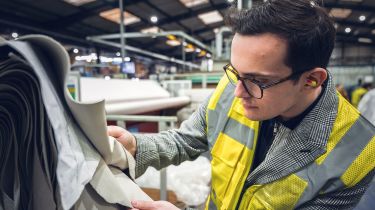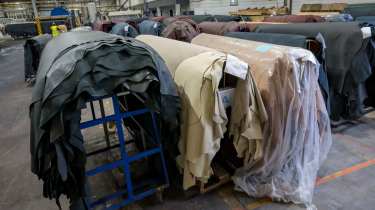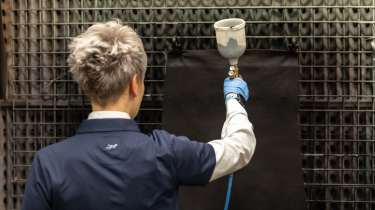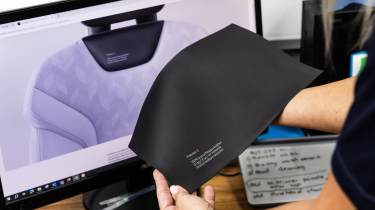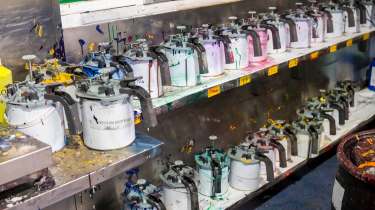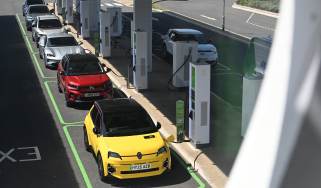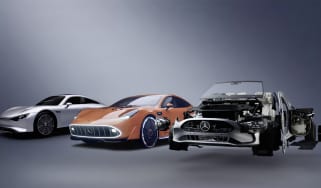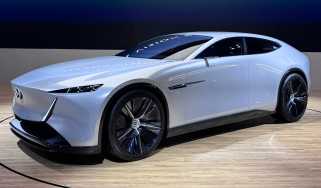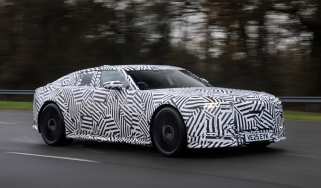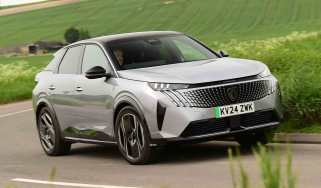Sustainable leather in cars: still an ethical choice?
We visit a leather supplier with Polestar to see if it can truly be considered an ethical and sustainable car interior choice
Can choosing to have leather in your car ever be considered the most ethical and sustainable option? That might sound like a trick question; hide, luxurious and hard wearing as it is, is still the by-product of a dead animal, and while many of us are guilty of consuming burgers, steaks and other meat products on a regular basis, the concept of slaughtering beasts on an industrial scale may not necessarily sound like the best choice for our planet – or our consciences.
Polestar, on the other hand, is one of the car manufacturers that continues to think otherwise. To show us why, it invited us all the way up to Scotland to visit Bridge of Weir, venerable purveyor of the finest automotive leather, including that used in Polestar’s growing line-up of electric vehicles.
In case you need to be brought up to speed, Polestar is a spin-off from Volvo that specialises solely in electric cars. After spending years as a performance arm of the Swedish giant, it became a standalone brand back in 2017, with the release of the limited-run Polestar 1 hybrid sports machine. This was subsequently followed in 2020 by the Polestar 2: an all electric rival to the likes of the Tesla Model 3.
With this in mind, you’re probably wondering why an EV firm – particularly one that prides itself on its pursuit of sustainability – would want to include leather in its cars. It’s a good point, especially given that other brands, including Volvo, have recently decided to go animal-free.
Well, Polestar believes it has found the sweet spot with its new partner and supplier, Bridge of Weir. The hide specialist is based in (you guessed it) Bridge of Weir – a small village just outside Glasgow – and we last visited the firm a few years ago, shortly after the Covid-19 pandemic. It’s safe to say that the company is no newcomer when it comes to the trade. BoW was founded all the way back in 1905 by one Arthur Muirhead, a man whose family had been involved in the leather industry ever since 1740.
In 1911, a few years after production began, Muirhead went to New York to have a discussion with Henry Ford, who was preparing to begin production of the Model T back over the pond in Manchester. Following a friendly chat and a cigar, Ford agreed to let BoW upholster these British-built models of his car, with the Scottish firm later going on to furnish the likes of Bentley, Rolls-Royce, the original Citroen DS, and even work in non-car-related areas such as Concorde, the RMS Queen Mary ocean liner and the House of Commons benches.
That’s quite the portfolio, but it doesn’t speak to the issue of sustainability; a study by the United Nations Industrial Development Organization (UNIDO) found that, on average, 1m2 of cow leather generates around 110kg of CO2, from raising the cattle to eventually turning the hides into leather. However, the Polestar 3 has BoW Nappa Leather seats that feature a stamp on the headrests highlighting a rating of just 8.1kg of CO2 per 1m2. You might be wondering how Bridge of Weir is able to keep emissions so low? In order to explain, CEO Nick Muirhead, Arthur’s great grandson, took us on a tour of the factory.
First, Nick is quick to remind us that BoW isn’t in the business of cattle farming; the firm simply buys hides from the meat-production industry, and would go out of business if we all suddenly decided to go vegetarian. Furthermore, roughly 95 per cent of BoW leather comes from British and Irish cattle; the other five per cent originates in Europe, and is primarily used for benchmarking purposes.
This means the hides come from cattle that have been raised according to the FAWC’s (Farm Animal Welfare Committee) five principles of making sure the animals are free from hunger and thirst, free from discomfort, free from pain and disease, free from fear and distress, and finally, free to roam. In fact, BoW’s accountability goes as far as stamping each hide with an individual barcode, to allow the leather to be traced all the way back to its source – even after it’s been tanned and used to upholster a car.
Speaking of tanning, this is one of the biggest issues in the global leather industry; many tanning agents use precious metals such as chromium, the mining of which causes huge environmental impact. In an effort to make itself even more sustainable, BoW recently introduced two new tanning agents: BioTan and FreeTan. Nick explains that the former includes more bio-based materials – or renewables, in plain English – than your average tanning agent, which should make it more sustainable in the long run. FreeTan takes things a step further, by eliminating all chrome and heavy-metal ingredients, while also enhancing the biodegradability properties of the leather.
And that’s not all. To minimise toxicity and any unwanted residuum, BoW also uses water-based dye pigments, of which the excess makes its way to the company’s on-site water-treatment plant. This purifies all of the liquids used in the leather-making process, and pumps the resultant clean water into the nearby loch. To reduce waste, BoW even goes as far as burning excess scraps in order to power parts of the plant, although the firm has a goal of being completely zero-carbon by next year – and not even by offsetting emissions, either.
It’s easy to get swept up by all the sanguine ingenuity on display at BoW. However, as we step outside, the ominous stench emanating from the tannery is a grim reminder of how the firm – and the leather industry as a whole – ultimately relies on and financially backs the meat industry, with 16,000 hides arriving at the factory weekly, and typically at least one being used to furnish each car.
With this on our minds, we speak to Polestar’s head of material and design, Maria Uggla, who has spent more than 20 years in the automotive industry. In this time, she tells us, customer demands regarding car interiors have changed markedly, especially when it comes to sustainability and using fashionable materials. “We are in the era where we need to be smarter with what types of material we use,” she tells us. “We need to be smart on the circularity aspect, and everything that has to do with chemicals in materials. I think everyone needs to realise that the way we live and the things we make aren’t sustainable.”
So why then, in a world where we’re constantly being encouraged to cut down on using animal-based products, has an automotive brand such as Polestar decided to continue equipping its vehicles with Nappa leather? Well, firstly it’s worth mentioning that it doesn’t solely offer its cars with hide upholstery; this is an optional extra on top trims, with the majority of models coming with cloth, wool and animal-free leatherette. In fact, all versions of the Polestar 2 get a faux-leather steering wheel, meaning the majority of cars that leave the factory are completely appropriate for those living a vegan lifestyle.
Nevertheless, animal leather is still available, and Uggla is keen to point out how the majority of vegan alternatives contain high levels of plastic. Even those boasting recycled materials typically aren’t biodegradable in the long run.
“I think it’s a good thing to use leather as long as we continue to live as we are, because I don’t see it as a solution to throw away an exquisite waste material to landfill, and then pump up crude oil to produce PVC or polyurethane.”
She continues: “I fully understand why people would not like to have anything connected to animals. I was born and raised in the countryside, and I cry for every animal dying… I’d never want to propose we use leather from animals that have been treated badly or are part of Brazil’s deforestation. However, if you use the right supplier, you can offer customers a choice to make an informed decision.”
This notion of choice seems to be the main takeaway of our time at Bridge of Weir. Polestar’s main argument is that offering leather in this form is the most sustainable option; not only does BoW’s product have a much lower carbon footprint than most hide, but it is also guaranteed in terms of animal welfare. And while choosing to go animal free may allow customers to distance themselves from the suffering of our fellow creatures, both Uggla and her colleagues at BoW will keenly remind you that most alternatives are not biodegradable.
It appears, then, that although many leather substitutes contain recycled materials, they are more of a short-term solution to a long-term problem, leaving buyers in somewhat of an ethical catch-22 situation.
This being the case, and for as long as you can go to a restaurant and order a steak, it’s inevitable that some manufacturers will stick to their guns and continue to offer animal leather as an option – hopefully making sure to ensure full transparency as to where the hides come from. But just as one can also choose to order a salad instead, shouldn’t it ultimately be up to the consumer to make that decision whether to go animal-free or not?
Wacky leather alternatives
Renault 5 - Recycled denim
Did you know that your old pair of Levi’s could have made it into this year’s hottest EV? The electric Renault 5 gets recycled denim fabric on the seats – a throwback to the R5 Blue Jeans Edition of the late eighties.
Range Rover Evoque - Eucalyptus Melange fabric
Range Rovers are known for being wrapped from wheel to wheel in the finest leather, but what should vegan customers do? Land Rover thinks it’s found the solution with posh fabrics made of eucalyptus – a plant that grows fast and consumes very little water.
Cupra Born - Seaqual recycled marine plastic fabric
There are estimated to be at least 171 trillion pieces of plastic floating in our oceans, and in a bid to rectify this, the Cupra Born gets special seat fabric that uses yarn containing reclaimed plastic from the seas.
Volvo EX90 - Nordico cork and recycled plastic leatherette
Unlike Polestar, Volvo has now gone leather-free across its entire EV line-up. The EX90 flagship features Nordico fabric, which is blended from recycled plastic bottles and corks used in the wine industry.
Mercedes EQXX - Deserttex cactus leatherette
Sitting on a cactus may not sound all that comfortable, but Mercedes has managed to turn the prickly plant into a new form of leather, blending it with polyurethane. A similar leather-like material, Mylo, swaps cacti for mushrooms, for those who would prefer to use something a little less spiky…
Find a car with the experts

